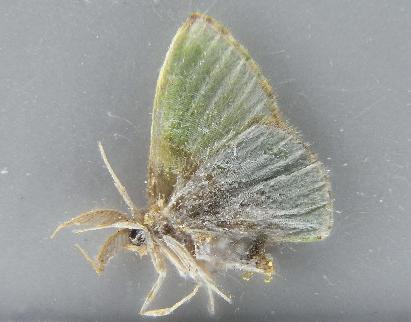
| (previously known as Probolosceles inductaria) (also known as Argyrocosma inductaria) GEOMETRINAE, GEOMETRIDAE, GEOMETROIDEA | (donherbisonevans@yahoo.com) and Stella Crossley |

(Photo: courtesy of
Daniel Kurek,
Cairns, Queensland)

| (previously known as Probolosceles inductaria) (also known as Argyrocosma inductaria) GEOMETRINAE, GEOMETRIDAE, GEOMETROIDEA | (donherbisonevans@yahoo.com) and Stella Crossley |

(Photo: courtesy of
Daniel Kurek,
Cairns, Queensland)
The Caterpillar of this species is brownish-green with spiny warts and tubercles on its back, to which it attaches detritus. The caterpillar has been found feeding on the flowers of
The caterpillar pupates in a thin cocoon incorporating debris amongst the flowers.
The adult moth has green forewings, each with a white line along the costa, and number of brown-edged white spots on all four wings. The wingspan is about 1 cm.

This species occurs across south-east Asia, and has been found in :
and in Australia in

Further reading :
Achille Guenée,
Uranides et Phalénites,
in Boisduval & Guenée:
Histoire Naturelle des Insectes; Spécies Général des Lépidoptères,
Volume 9, Part 9 (1857), p. 370, No. 588.
George Francis Hampson,
The Lepidoptera Heterocera of the Nilgiri district,
Illustrations of typical specimens of Lepidoptera Heterocera in the collection of the British Museum,
Part 8 (1891), p. 110, and also
Plate 151, fig. 15.
 caterpillar |  butterflies |  Lepidoptera |  moths |  caterpillar |
(updated 22 January 2010, 4 July 2021)